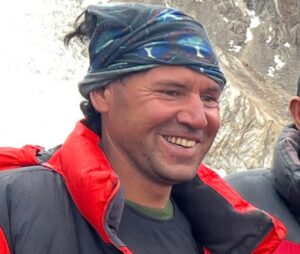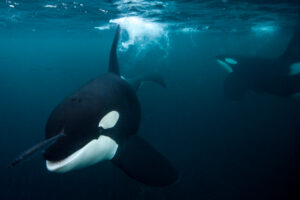It’s ironic that when you’re climbing Mount Everest, you’re less aware of events happening elsewhere on the mountain than people reading the news at home. Often I receive a message from a friend stateside, or even from my mother, about a fatality before I have heard about it through the Khumbu grapevine. As an expedition leader, I’m dialed in to the state of rope fixing, traffic of large teams and suspect groups to avoid. But when I eventually got wind that a couple of parties were trying to link up Everest and Lhotse without O2, it was news to me!
This marked my sixth year guiding Everest, and one word described the current state of mountain for me: quiet. This is surprising, given the record number of ascents this season. The mellow vibe owed to a few reasons: First, the number of foreign climbers was down a bit from previous seasons. Second, expeditions keep more to themselves at Base Camp (5,380m) these days. For example, you don’t see the grand parties of past years, when random groups threw a shindig during rest periods that seemingly everyone showed up for. Third, the more organized rope-fixing crew on the Nepal side meant that western leaders held fewer meetings to discuss sharing manpower and gear. Finally, the long spell of good weather let teams spread out over several days, limiting crowds at the traditional bottlenecks.

Steep ice near Camp Two
When you are on the Nepal side, you pay little attention to what is happening on the Tibet side, and vice versa. Now and then, we do check how the rope fixing is going on the other route. This year, when we heard about the major O2 regulator malfunction in Tibet, we ourselves began to worry about those little hunks of metal so vital to our climb. We reassured the team that “ours will work just fine”. In Nepal, the usual film projects and TV shows unfolded: The Quest Nepal and a CNN special are two interesting projects now in post production.
Our team shared lunch at Camp 3 (7,200m) with the Benegas crew, just before their ski descent down the Lhotse Face. It was awesome to watch, very rare and burly, but otherwise it seemed pretty uneventful to us. But back at Base Camp a day later, we found that all hell had broken loose because of the unauthorized ski run. Rumors floated about fines, possible expulsion from Nepal, etc. A large number of Sherpas rallied together at BC in support of the foreigners, who were just trying to do a simple adventure with sticks on their feet instead of a rappel rope. Eventually, the whole drama worked itself out.

Base Camp helicopter
Base Camp is still big and spread out but has subtle changes noticeable to long-time visitors but not to a first-time climber. Some of the legacy big guide services have smaller camps or have even dropped out of the picture, as market forces change. A couple of low-cost operators have expanded their massive footprint. It also seems that a new helicopter pad springs up out of the rocks every year. There are still politics, disputes, bottles of Johnny Walker shared among certain amicable expedition leaders and even romances. But groups are so much more insular, as the goal is now to make your team’s bubble so comfortable that there is no reason to leave it. Only helicopters shatter the quiet vibe.
Mountain Camps: On our first foray to Camp 1, it struck me how few tents there were. This, of course, ebbs and flows over the season, as groups do their rotations and eventually take down all but one or two tents as emergency shelter or storage. Camp 2 (6,400m) has stayed roughly the same size, although it has begun to sprawl out onto the glacier toward Nuptse, as groups search for easy water access.
The helicopter traffic in Camp 2 has increased quite a bit. A YouTube search can show you the time a helicopter supposedly landed on the summit (one skid), but we do occasionally see long-line rescues as high as Camp 3. The ability to fly higher with better machines is good for small loads, emergency evacuation and moving rope-fixing gear safely over the Khumbu Icefall. However, an aesthetically negative side effect is the people flying down from C2 just because they want to. A Nepal Sherpa mountain guide died in a crevasse this season while marshalling a helicopter onto the helipad. That helicopter was not rescuing anyone, it was picking up foreigners who wanted a taxi ride down after their climb. It was a total tragedy.

In the Western Cwm
Camp 3 is more compact this year. Very few tents at the upper C3 location, as more groups opt for the lower C3, on the ice ledges. It makes for a longer day up to C4 (7,950m), but as the glacier shifts, this may be inevitable. Last but not least, C4 has become dirty again. We had many discussions among our group about possible fixes for the rubbish. There are not as many O2 bottles as there used to be, because local people are paid to bring them out. The problem is the small stuff that collects in the ice, such as plastics wrappers and old cooking gear. Human waste is also a concern, as most people simply walk to a quiet spot to do their business. It freezes and remains for years.
Sadly, some groups (unnamed but worthy of outing) just cut their logo from their cheap Chinese-made tents to make them anonymous and left them there, rather than carry them down. The Sherpas will have to address this, as they know who is doing it and can pressure the operators to change. By some miracle, my team even had some oxygen bottles get up and walk out of Camp 4 on their own. But that is a whole other topic that my partner and I can curse about ad nauseam over beers in Kathmandu, if you wish to hear.

1st group of the Mountain Professionals team on Summit
Summit Days: Much debate has swirled around the Hillary Step’s current condition. Did it collapse or disappear? No, but it is pretty evident that the large blocks to the climbers’ left have moved or shifted enough that the feature is now better termed the Hillary Staircase. A nice slope of snow has collected in the corner of what used to be a steep face requiring mid-range mixed climbing on the fixed line. Now, mounting the Hillary Step is as straightforward as any other 50-degree snow slope with steps cut into it. Descending just requires an arm wrap instead of a rappel, which makes for much faster progress and fewer traffic jams.
The prolonged good weather from May 15-22 made for a much smoother season. Our team spent roughly 40 minutes on the summit on May 21 with no one else on the top. In keeping with my “quiet” theme of this season, the solitude was very welcome!
—
Ryan Waters is a mountain & polar ski guide and the owner of Mountain Professionals. He is a veteran of 22 Himalayan Expeditions. Read his bio here.






